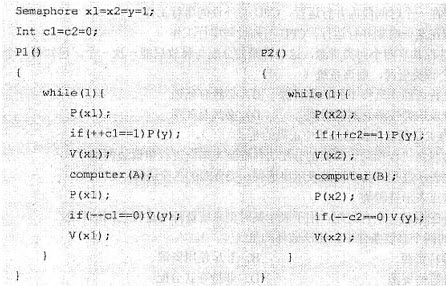问题
单项选择题
下面是一个并发进程的程序代码,正确的是()。

A.进程不会死锁,也不会“饥饿”
B.进程不会死锁,但是会“饥饿”
C.进程会死锁,但是不会“饥饿”
D.进程会死锁,也会“饥饿”
答案
参考答案:B
解析:
仔细考察程序代码,可以看出是一个扩展的单行线问题。也就是说,某单行线只允许单方向的车辆通过,在单行线的入口设置信号量y,在告示牌上的车辆数量必须互斥进行,为此设置信号量x1和x2。若某方向的车辆需要通过时,首先要将该方向来车数量c1或c2增加1,并查看自己是否是第一个进入单行线的车辆,若是,则获取单行线的信号量y,并进入单行线。通过此路段以后驶出单行线时,将该方向的车辆数c1或c2减1(当然是利用x1或x2来互斥修改),并查看自己是否是最后一辆车,若是,则释放单行线的互斥量y,否则保留信号量y,让后继车辆继续通过。双方的操作如出一辙。考虑出现一个极端情况,即当某方向的车辆首先占据单行线且后来者络绎不绝时,另一个方向的车辆就再没有机会通过该单行线了。从而造成“饥饿”。由于有信号量的控制,死锁的可能性没有了(即双方同时进入单行线,在中间相遇,造成双方均无法通过的情景)。
